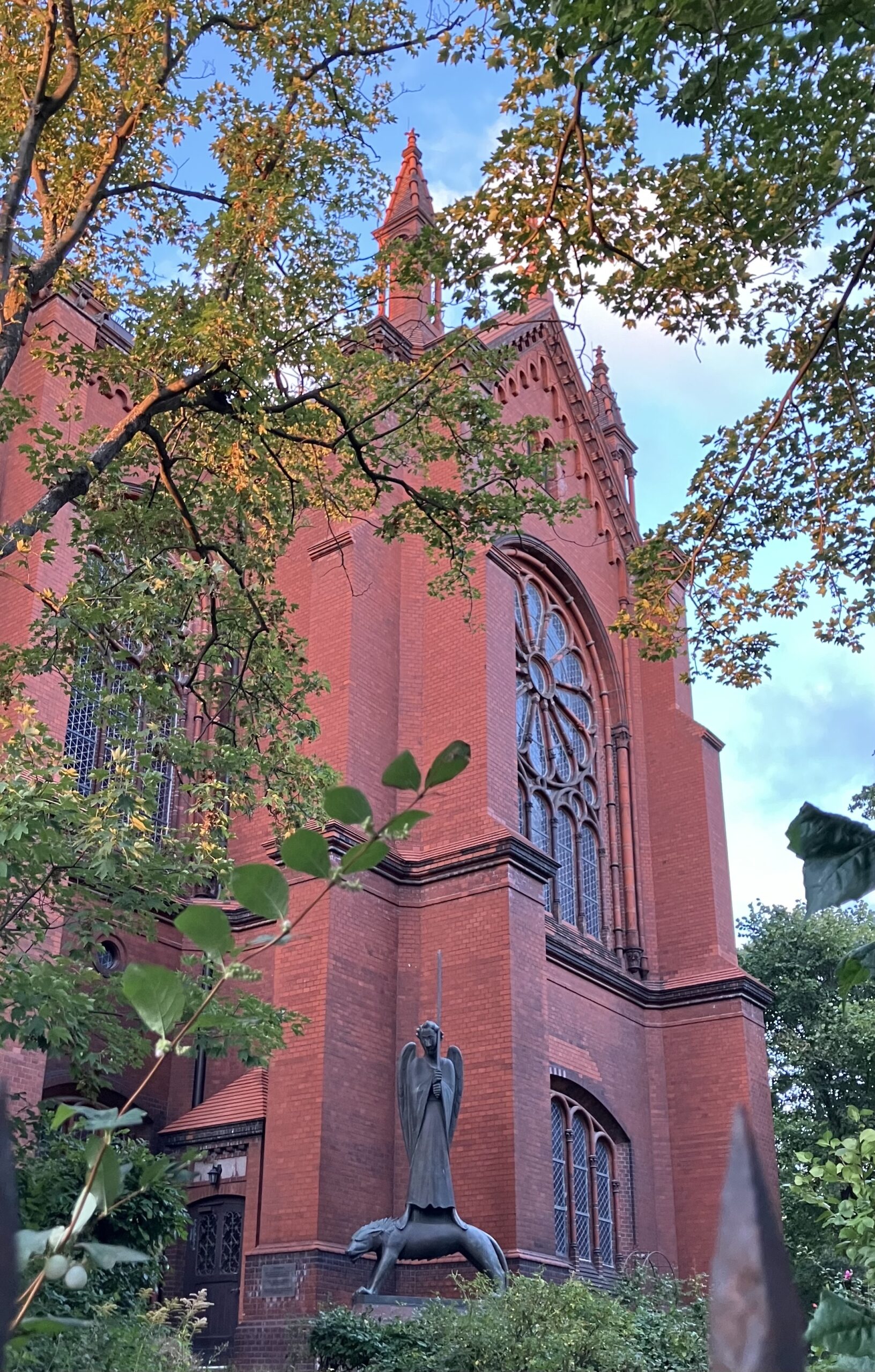One of the beautiful mysteries of this journey that I’m on is that it echoes one that has shaped my life profoundly: my mom’s own journey to Germany for her masters degree (in German) as a 22 year old in 1968. My mama, Karen Seay, has agreed to share occasional reflections here, as my adventures conjure memories of her own. Here’s the first one. – E
Last Wednesday evening I did something I haven’t done in a long time; I cooked a “southern” dinner: long-simmered collard greens with tiny tender turnips, dried blackeyed peas soaked, then also long-simmered with aromatic vegetables, baked sweet potatoes, macaroni and cheese, and sauteed eggplant. Ted made his good cornbread. All this was, atypically, vegetarian, because I made it for Emilia, our 40-year-old daughter, who is vegetarian and was to leave the next night for Berlin and a two-year course of study for an MFA in devised theater at Arthaus Berlin. We had gathered close family and one of Emilia’s dearest friends and ate on the deck with the perfect half-moon in the southern sky over our shoulders. It was a second lovely farewell gathering of the week, and it was bittersweet, but mostly sweet, with much warmth and laughter.
On Thursday afternoon Ted and I drove Emilia to the airport, and before we knew what was happening, she was struggling to wheel a large cart bearing her bicycle packed in a huge unwieldy carton, two mammoth suitcases, her faithful giant pink duffle bag, and her plaid backpack very awkwardly past the security stanchions and into the airport. It would be three more hours until her flight left for Amsterdam, but we had stood at the curb and hugged, and spoke, and and hugged some more and wept our goodbyes. Her adventure had begun.
I have very mixed feelings about Emilia going away for two years. I still have fresh memories of driving away and leaving her at her college in upstate New York in 2003. My overwhelming feeling for her now is excitement and pride in the fact that she has the courage and the determination to interrupt a comfortable, familiar, successful life, to give up a great job with people she loves at the Episcopal Diocese of Minnesota, and to sell her beloved condo seven blocks from Ted and me , all at the age of 40, to move across the world to pursue what she feels deeply called to do after a long and searching time of discernment. I have told her since she was a little girl that I hoped she would someday get to live outside the U.S. for an extended time. (She has lived and worked in Italy for three summers, which only whetted her appetite for this journey.) Without taking anything away from my excitement and my pride for and in her and this venture, I also must claim my extremely heavy heart, knowing that she will be so far away for two years and that life and her art may take her far from Minneapolis even after that.
I’m keenly aware of all my very nearly 78 years right now, along with my seriously deteriorating hearing, plus my increasing difficulties with mobility. Whether I will be able to travel to visit her is uncertain, and whether and how often she will be able to get back home for visits is also remains unclear. I freely admit to being an old hen with one chick. The two of us, I think, are uncommonly close; I don’t expect that to ever change, but it will be different now at such a distance. And yet, somehow, I believe we will learn to interact and share in new and meaningful ways, perhaps because of the distance and some of the commonalities we share. Exactly 56 years before last Thursday evening, I was aboard a German Atlantic Line ship, the TS Hanseatic, somewhere in the north Atlantic on the way to Bremerhaven to dock with my fellow German Fulbrights for 1968-69 for a year’s study in what was then West Germany. Emilia and I have talked about how her decision to study in Berlin has some echoes of my year of graduate
study at the University in Mainz. But I have no illusions that she is following in my footsteps. She has always been her own person and makes her own decisions for her own reasons. Still, I can’t help being more than ordinarily curious about what her experiences in Berlin, Germany, and Europe in general will be in 2024 compared to mine in 1968.
While I spent only one week in Berlin during that year, it was a vastly different city than it is now, 36 years after German reunification, a development that I still find hard to believe really happened after my experience of living in divided Germany. I also find it hard not to note that I was encountering Germany a mere 23 years after the end of World War II and the fall of the Third Reich. Emilia is encountering it 79 years after those events, but in a new and fraught era when extreme right-wing forces seemingly bent on new iterations of fascism are actively seeking power in the U.S., in places in Europe, including parts of Germany, and in other parts of the world. I was privileged to cast my vote for Hubert Humphrey and against Richard Nixon for president shortly after I arrived in Mainz; Emilia recently mailed her absentee ballot to vote for Kamala Harris and against Donald Trump shortly before she left last Thursday.
Since Emilia arrived in Berlin last Friday, we have been in touch via FaceTime and via texting, something I could not have fathomed in 1968. Although she has gone through some apartment angst and ended up with a different and less attractive apartment than she had contracted for, she soon decided she could stay in the one she has for the first three months and then find a different permanent residence. She announced to us early on that she has “fallen in love with” her neighborhood, and she has been eagerly exploring it and the wider city ever since, since her program at Arthaus doesn’t begin until September 23.
One of the very first pictures Emilia sent us was of a church that she passed just down the street from her apartment building, the Gethsemane Church. It’s a red brick building with a tall steeple. Outside the front entrance stands a sculpture of an erect figure, an angel with large wings and a sword held in his hands and pointing straight upwards. He stands in a fighter’s wide stance on the back of a lion, as if on guard. The piece is called “Der Geistkämpfer” (“The Spiritual Fighter”). It was created by Ernst Barlach (1870-1938), a German expressionist artist, sculptor, and writer whose work became highly disfavored by Hitler and the Nazi regime. Here is an excerpt from the Wikipedia article on Barlach:
“The Fighter of the Spirit (Der Geistkämpfer), commissioned by the University Church of Kiel in northern Germany, was intended to be a memorial to humanistic and intellectual ideals in the aftermath of World War I (1914–18). The Nazis, angered by its anti-war message, removed it in 1937 and sawed the angel in parts—intending to melt it down. Instead, it was saved. In 1953, following World War II, it was repaired and installed outside the Church of St. Nicholas in Kiel (the University Church was destroyed during the war), but not before copies were made. The Minneapolis Institute of Art acquired one in 1959 and today it stands at the 24th Street entrance to the museum, the saw marks still visible.”
The copy of the sculpture at MIA stands at the entrance on Third Avenue, just south of 24th Street, where Ted and I pass by and see it almost every single day, just as Emilia now passes by the copy that stands at Gethsemane Church, just a block or so from her apartment building in Berlin. This is the kind of strange and wonderful coincidence that Carl Jung noted and called “synchronicity,” and when it happens, it still never fails to make me catch my breath a little at the depths of what we humans are not equipped to understand about this life.
But let me add one more detail to the synchronous fact that two existing copies of what I believe to be an extraordinarily meaningful (particularly in today’s world) piece of sculpture each stand within a few hundred yards of where Ted and I and Emilia live, even though we are separated by thousands of miles. When I was living in Mainz in 1968, one of my friends from the ocean voyage to Germany, in fact one of my three roommates in a tiny cabin on the lowest level of the Hanseatic, was an amazing woman who found on that journey that she was pregnant. She was very sick and alone and desperate, and she and I—her name is Judy—became friends by singing together as Judy played her guitar during that voyage.
Much happened between Judy and me after we arrived in Germany, a difficult story involving ignorance and stubbornness on my part that ultimately resulted in a fifty-two-year silence between us. (I think it’s important to interject here that in 2021 I went in search of Judy in order to offer her an abject apology and to try to learn if, by some miracle, she could forgive me. Her quick and ready willingness to do so still astonishes and humbles me. We have been in regular touch via email, phone calls, and Zoom ever since. That blessedly renewed friendship is now one of the joys of my life.)
For Christmas in 1968, Judy, who was Jewish and who was studying in Bochum, an industrial city north of Mainz, sent me a present, a large black and white calendar in which each page held a picture of a different Barlach sculpture. One of the pictures in the calendar was of “Der Geistkämpfer.” That was the first time I had ever encountered it. The beautiful calendar hung in the tiny efficiency apartment I shared with my roommate Melissa in Mainz, and then, when I returned to the U.S. in 1969, the calendar came with me, and with its pages I decorated the walls of my classroom at my high school where I taught during the first year of the court-enforced racial integration of the schools in my South Carolina hometown.
The Barlach spiritual warrior was there in Inman in 1969-70 watching over those profound changes and those students and teachers and administrators and all of us. I know it would have been harder to have made it through that incredible school year without the presence and inspiration of those pictures on the walls of my classroom. The assistant principal at the school, a former student of the school like me, who was monitoring standardized tests in my classroom one day, left a note on my desk to express his appreciation for the company of those moving Barlach figures in our particular time and place and situation.
This past Saturday was Emilia’s first full day in Berlin. Saturday was the day she found the Barlach sculpture and sent the picture. And then, I started to think back and remember and look at the dates.
This past Saturday was September 14, 2024. On Saturday, September 14, 1968, exactly fifty-six years ago to the day, the Hanseatic sailed into the harbor at Bremerhaven. I remember so clearly standing at the railing and watching in awe as my first glimpses of Germany and Europe and my new life came into view. Then, when the ship had docked, I walked down the gangplank onto German soil for the very first time.

